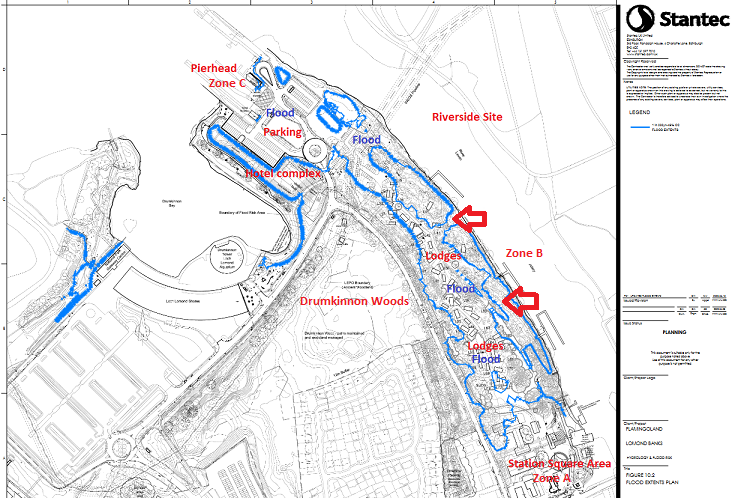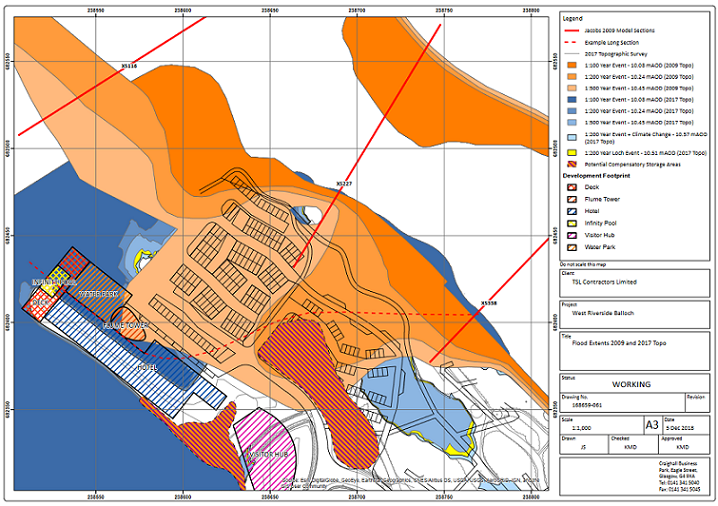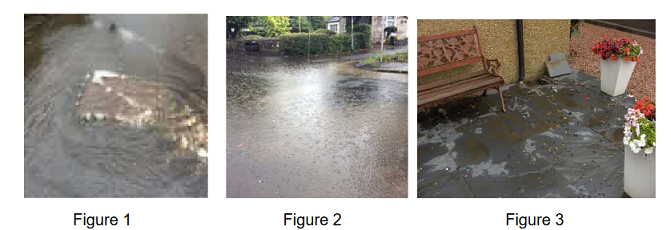
On 28th July the Scottish Environmental Protection Agency (SEPA) lodged a response to the Flamingo Land Planning Application (see here) which could scupper a large part of the proposed development:
“The outputs of the FRA [Flood Risk Assessment] (illustrated in Appendix G) [see map above] indicate the majority of Zone B – Riverside and part of Zone A – Station Square is in the flood risk area. We therefore request the Zone A and B layout, as shown in EIAR Appendix 2.1 – Parameters Plan, be modified to remove development from the flood risk area. If these changes cannot be accommodated, then please consider this representation as an objection.”
Zone B, currently a public park and green space, was to be developed with 42 (or was it 43?) holiday lodges and associated parking places. As the map shows, only a handful were planned for the higher land above the River Leven, the most important access route through the site. With Flamingo Land having reluctantly accepted earlier this there should be no development in the ancient woodland area of Drumkinnon Woods (see here) there is literally nowhere else for the lodges to go. That could blow a big hole in the centre of the proposed development, as the Daily Record reported today (see here), and Flamingo Land’s business plan.
Background to the revised flood risk assessment
In October 2022 the Loch Lomond and Trossachs National Park Authority (LLTNPA) wrote to Flamingo Land asking them to clarify how the plans they submitted last summer fitted with the draft National Planning Framework 4 (NPPF4) which was subsequently adopted early this year One of LLTNPA officers’ requests was for a new Flood Risk Assessment because of the stricter requirements in NPPF4 on developments and flooding which have resulted from climate change and the increase in extreme weather events.
While Flamingo Land responded to most of the points in the LLTNPA’s letter on 13th February 2023 and produced revised plans for the development (see here), there was no flood risk assessment. This was only submitted on 30th June in a dogs breakfast of 13 documents added to the Environment Impact Assessment Report (EIAR). The documents are almost impossible to follow, contain basic mistakes (as a member of the public showed in an objection lodged on 4th July) and some of the accompanying maps were unintelligible. There was nothing either to explain how the suite of documents fitted together or the implications and that the LLTNPA simply uploaded them without asking Flamingo Land to make them intelligible to the public tells you something about the rotten planning process.
Luckily for the public, however, SEPA has made sense of the paperwork and in one short response (see here) highlighted what really matters.
The implications of SEPA’s response to Flamingo Land’s plans for the pierhead
Flamingo Land and the LLTNPA always knew the Pierhead Area was at risk of flooding and had squeezed the hotel and leisure complex, not entirely successfully, onto the higher ground in Zone C as this map from 2018 contained in the revised Flood Risk Assessment illustrates:

As a result of NPPF4, the height of land around Loch Lomond identified as being at risk of flooding has risen slightly from 10.57 to 10.65m AOD (Above Ordnance Datum or “mean sea level”). As importantly, however, NPPF4 has introduced a much stricter approach to developments on land at risk of flooding.
SEPA accepts that most of Flamingo Land’s leisure complex at the Pierhead, as set out in the planning application, will be 10.65m AOB but has recommended two conditions to the LLTNPA that will be difficult to meet. While SEPA is prepared to accept “the water park component [i.e the proposed swimming pool] could be considered to be a water compatible use as per our Flood Risk and Land Use Vulnerability Guidance” and so can be built on land at risk of flooding, that is only “as long as no landraising is to be undertaken”.
SEPA requires a similar condition, that no landraising is undertaken, for the parts of the “multi-user public realm” at the Pierhead which are also in the flood risk area. They also note that the water park “is currently to form part of the overall Pierhead Visitor Destination building” with the implication that it will need to be a separate building for them to give the go-ahead.
It is going to be extremely challenging for Flamingo Land to re-design the buildings to meet SEPA’s requirements. The risk is that they do what many developers do in such circumstances, provide vague undertakings that they will address the issues, gain planning permission in principle and then come back to the planning authority to say the required modifications are unaffordable and ask them to make an exception to the rules. SEPA, however, in their Disclaimer has made it very clear that “We prefer all the technical information required for any SEPA consents to be submitted at the same time as the planning or similar application”.
The LLTNPA should therefore require Flamingo Land to provide this information now, at the planning permission in principle stage, and show it can build a viable leisure complex on a spit of land that will be almost surrounded by water at some point in future and where all the car parking will be submerged.
While the architects and engineers may still be to design a development that meets the technical requirements, in truth it never made sense from a flood risk perspective to build a major development on the flood plain along the River Leven.
The implications of SEPA’s response to Flamingo Land’s plans for Zone B (the park)
In the revised Flood Risk Assessment they submitted on behalf of Flamingo Land, Stantec proposed that flooding of Zone B and its holiday lodges could be prevented by raising the back of the car parking area in Zone A and filling a gap in the banks along the River Leven. In their response SEPA point out that they had “previously advised this cannot be taken into account as it is not a formal flood
protection scheme” and re-affirmed that:
“these are informal measures that we cannot support both on technical grounds and by way of them not being viable as it is not currently confirmed that the proposals meet the exceptions defined within NPF4 Policy 22a. If the Planning Authority determine development in this area meets the exceptions, we can review this position and associated information requirements at that point. Please note
however informal flood protection measures would not be taken into account when considering development behind or benefitting from them”.
The exception in Policy 22a of NPF4 that could be used to save the holiday lodges is (iv):
“redevelopment of previously used sites in built up areas where the LDP has identified a need to bring these into positive use and where proposals demonstrate that long-term safety and resilience can be secured in accordance with relevant SEPA advice”.
The LLTNPA has a long track record of manipulating planning policy to allow developments to go ahead (see here for example). It would therefore be quite capable of using past historical use to argue that the area of green space along the River Leven is in fact a built up area. It could also argue that when the Riverside Site was designated for Visitor Experience in the Local Development Plan that meant every inch of the land was to be developed even though this was not explained to the public at the time. It could therefore risk ignoring public opinion and find ways to get round NPF4 and grant permission for the lodges to go ahead. It is important therefore that people lodge new objections to the application based on what is said in the Flood Risk Assessment.
What the LLTNPA could not do, however, is get round SEPA’s objections to any informal flood defences, such as raising the land. Formal flood defences are going to cost a lot of money besides having a significant impact on the local landscape at the gateway to the National Park. The implications for the development don’t stop there as SEPA also notes that the design of the proposed monorail will require to be altered so none of the supporting pillars are in flood risk areas (where they could for example be damaged by trees being swept downstream). Whether that can be done remains to be seen.
Any National Park Authority which was true to its conservation, outdoor recreation and sustainable development objectives should now be rejecting Flamingo Land’s proposals for holiday lodges in Zone B outright. Instead, the LLTNPA’s last public pronouncement on Flamingo Land was back in February (see here). One possible explanation is that their senior management are now scrabbling around trying to save the development which they have backed from the start (see here).
The implications of SEPA’s response to Flamingo Land’s plans for Zone A the Station Square
To add to Flamingo Land’s woes SEPA helpfully record – I cannot find a map that shows this clearly – that:
“the area of Zone A earmarked for the brewery building is in the flood risk area. Therefore, in line with the principle of flood risk avoidance promoted by NPF4 we request the modification of Zone A so no development occurs in the flood risk area”.
The implications of SEPA’s response to Flamingo Land’s plans for Woodbank House
The revised Flood Risk Assessment skates over the implications for the land at Woodbank House which Flamingo Land owns and also wants to cover with holiday accommodation.
Most of the land is on a hill, so not itself at risk of flooding, but if the area was developed the amount of water run-off into the burns would increase significantly. The problem, which has has been well described in an objection by a local resident (see here), is the houses along Old Luss Road are already subject to severe flooding from water above and that sewerage capacity is insufficient to deal with this:

SEPA has acknowledged these concerns and has now indicated it will require a full Flood Risk Assessment for the area:
“No detailed FRA work has been undertaken for this part of the development yet however,
as agreed previously we will be happy to review a detailed FRA at the full planning stage
where avoidance should be upheld for areas identified at risk, including those caused by
blockage of culverts/ bridges. To secure this we require a planning condition be applied
which requires the final design of Zone E be supported and informed by a detailed FRA
showing all development to be outwith the flood risk area.”
Mitigating the flood impacts will not only cost Flamingo Land money, it might also force them to reduce the number of accommodation units (currently c90) and associated car parking spaces planned for the site which might further reduce the profitability of the proposed development.
Where next for for Flamingo Land and the LLTNPA?
There now appear to be three options for Flamingo Land:
1) To press ahead with the existing plans and hope the LLTNPA will grant planning permission in principle contrary to the advice of SEPA. Under current planning rules that would automatically trigger a review of the decision by Scottish Ministers and would become a test case for NPF4. With the Greens opposed to the development and a Green MSP, Lorna Slater, responsible for National Parks, that appears unlikely. Stranger things have, however, happened and it may depend on what is going on behind the scenes.
2) To revise their proposals for the fourth time. While the LLTNPA let them submit revised proposals in February without a new application, that was contrary to good planning practice and Scottish Government Guidance. They are unlikely to get away with doing this again. Given the level of public opposition to the development if this happened it should be quite possible to crowd fund a legal challenge through the courts. The most probable outcome is that if Flamingo Land still wishes to go ahead with a development (and can afford it) they will need to withdraw the current application and submit a new one.
3) To withdraw the application and drop the whole development for the Riverside Site. Given Flamingo Land’s business model – which is based on developing major visitor attractions – this could also result in them deciding to ditch their proposals for Woodbank House and sell the site.
Time to re-assert public control and put the public interest first
Whichever way it goes now, the Riverside Site at Balloch has now turned into one of the greatest planning disasters in Scottish history, over ten years wasted because of Scottish Enterprise’s and the LLTNPA’s undemocratic decisions to turn Balloch into a commercial holiday resort. The current planning application was submitted 14 months ago, comprises 641 documents and is going nowhere fast. The whole planning process needs to start again and start by developing a new plan for Balloch designed in the public interest to support the local community, enable visitors to enjoy the area sustainably and help deliver the National Park’s conservation objectives.
There are far too many skeletons in both SE’s and the LLTNPA closets either to conduct a meaningful examination of what has gone wrong or to develop a place plan for Balloch which is fit for the purpose. Indeed as I showed in my recent post (see here) the LLTNPA has deliberately manipulated their local place plan process to exclude Balloch the most popular visitor destination in the National Park. A disgraceful situation!
What is now urgently needed therefore is an independent inquiry into what has gone wrong (the LLTNPA Board who have consistently failed to hold their Chief Executive and management team to account (see here) simply cannot be trusted). As a quick reminder, here are just some of the issues that need to be investigated (I would be happy to produce a more comprehensive list for the Scottish Parliament or the Minister responsible, Lorna Slater):
- The LLTNPA’s involvement in the selection of Flamingo Land, starting with the previous CEO’s visit to Yorkshire and then their role on the interview panel;
- How the LLTNPA allowed the land they owned at the pierhead to be included in the original planning application without this ever being discussed by their Board (see here);
- The LLTNPA’s decision last year to hand back the Gateway Building at Balloch to Scottish Enterprise in a move that could help Flamingo Land come up with alternative proposals;
- Why the LLTNPA decided to allocate so much land at Balloch for development in their Local Development Plan in what is supposed to be a National Park and without taking any cognisance of the needs of the local community;
- The failure of the LLTNPA to uphold the policies in their LDP which should have prevented the development from getting this far, from development in ancient woodland to traffic and parking to flood risk. Despite being ostensibly committed to achieving net zero, for example, the LLTNPA has still not required Flamingo Land to produce a proper carbon impact assessment.
An inquiry into these issues could result in heads starting to fall, starting with the Chief Executive of the LLTNPA, who lied about the LLTNPA’s involvement in the appointment of Flamingo Land but was then protected by the previous Convener of the National Park, James Stuart, who refused an independent investigation (see here). Only once there is a clear out of the senior management team and the board members who support them will it become possible to develop a new place plan for Balloch.
Within this context, SEPA’s recent response to Flamingo Land’s proposals is most welcome, not just because it put a spanner in the works but it provides the opportunity to re-think the whole development. It should be a matter of common sense to say that low lying land which is at risk of flooding, such as that along the River Leven at Balloch, should be dedicated to nature and public enjoyment, not to development and private profit. Unfortunately we have a National Park Authority that is so rotten and has so lost sense of its own purpose that it is incapable of appreciating that simple fact.

Thanks Nick. There were plans drawn up for that site before the banks crashed 2008. I’ve forgot their name. They went bust like myriad other junk bond and pump-and-dump schemes at that time. We’re still paying their bills. Really all you need to know is there’s no such thing as “true capitalism.” Most if not all of The Loch interests were into HBOS. Local lad, Peter Cummings, “Lender to the Stars,” was head of Corporate Lending. He was fined £500,000 and banned for life. Raised in Brucehill and lived 2mins from Barloan Roundabout. Another “great humanitarian and charity worker.” Aren’t they all? Sidewinder, Labour’s Lord McFall said, “It’s the culture.” lol That guy’s a joke. What SEPA are referring to is a proper Flood Risk Management Scheme. They won’t support piecemeal attempts at that. The last one I was involved in, via Glasgow City Planners and others, was the Cart Scheme. Civil Engineering at Strathclyde Uni and others at Glasgow Uni were in on that as well. £50 million all told. Half of that was for compliance/legal work. Glasgow City’s initial estimate was £20 million. Again, that’s public money used to bail out private property speculators and shore up asset values before these developments on flood plains become uninsurable. These people have already demonstrated their denial, dereliction, contempt and neglect for the River Leven for generations. We need to call in the hangman and string them up from the gallows before they do any more damage.